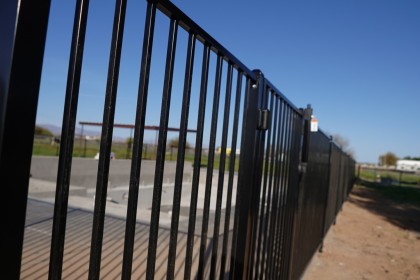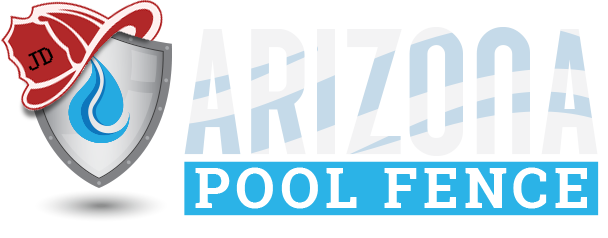How to Maintain Your Pool Fence in the Arizona Heat

Pool fences are essential for ensuring the safety of your family and guests, providing a physical barrier that prevents accidental pool access. In Arizona, where pool ownership is common, local regulations mandate the installation of these fences to enhance safety and reduce drowning risks. However, maintaining a pool fence in Arizona’s intense sun and heat presents unique challenges. The relentless UV rays and high temperatures can cause materials to deteriorate quickly, leading to issues like fading, warping, and rust. At Pool Fences in Phoenix, we understand these challenges and offer solutions to help you keep your pool fence in top condition year-round.
Understanding the Impact of Arizona’s Climate
Arizona’s intense sun and heat can significantly impact the durability and appearance of pool fences, especially when considering materials like wood, metal, and vinyl.
Wood: Wooden pool fences are aesthetically pleasing but highly susceptible to Arizona’s harsh climate. Prolonged exposure to UV radiation can cause the wood to fade, dry out, and crack. Temperature fluctuations exacerbate these effects, leading to warping and splitting. Additionally, the dry conditions in Arizona can cause wood to become brittle, making it more vulnerable to damage and decay.
Metal: Metal fences, commonly made of aluminum or wrought iron, are durable but not immune to the effects of extreme heat and sunlight. UV radiation can cause the paint to fade and peel, exposing the metal to the elements and increasing the risk of rust and corrosion. Temperature fluctuations can also lead to the expansion and contraction of the metal, potentially weakening joints and welds over time.
Vinyl: Vinyl fences are popular due to their low maintenance and resistance to moisture. However, they can still suffer from the intense Arizona sun. UV radiation can cause vinyl to become brittle and discolored, leading to cracks and breaks. While vinyl doesn’t warp like wood, the high temperatures can cause it to soften and sag, particularly if it is not UV-resistant.
Arizona’s climate poses significant challenges to all pool fence materials, making regular maintenance and protective measures essential to ensure their longevity and functionality.
Regular Inspections and Maintenance Routines
Routine inspections are crucial for maintaining the safety and integrity of your pool fence, especially in Arizona’s harsh climate. Regular checks can help identify early signs of wear and damage, allowing for timely repairs and preventing minor issues from becoming major problems. This proactive approach not only extends the life of your fence but also ensures it continues to provide the necessary safety barrier around your pool.
Here’s a checklist to guide your pool fence inspections:
- Checking for loose or missing parts: Examine all components, including screws, bolts, and brackets, to ensure they are secure and in place. Tighten any loose parts and replace missing ones immediately.
- Looking for signs of rust or corrosion (for metal fences): Inspect metal fences for any rust or corrosion, particularly at joints and welds. Rust can weaken the structure, so address any spots with appropriate treatments or touch-up paint to prevent further deterioration.
- Identifying cracks, warping, or discoloration (for wood and vinyl fences): Look for any cracks, warping, or discoloration in wooden or vinyl fences. These signs indicate damage from UV exposure or temperature fluctuations. Replace or repair affected sections to maintain the fence’s structural integrity.
- Ensuring the gate and locks function properly: Test the gate to ensure it opens and closes smoothly and that the locks are secure and functioning correctly. A malfunctioning gate or lock can compromise the safety of your pool area.
Cleaning Your Pool Fence
Cleaning your pool fence regularly is essential for maintaining its appearance and longevity. Here’s a step-by-step guide on how to clean different types of fences and tips for removing algae, mold, and mildew.
Vinyl and Metal Fences
- Prepare Cleaning Solution: Mix a solution of mild soap and water. Avoid using harsh chemicals that can damage the material.
- Rinse the Fence: Use a garden hose to rinse off loose dirt and debris from the fence.
- Scrub the Surface: Dip a soft brush or sponge into the soapy water and scrub the fence gently. Focus on removing any dirt or stains.
- Rinse Thoroughly: After scrubbing, rinse the fence thoroughly with clean water to remove all soap residues.
- Dry the Fence: Allow the fence to air dry, or use a clean towel to wipe it down.
Wooden Fences
- Prepare Cleaning Solution: Use a wood-safe cleaner or create a mixture of vinegar and water for a natural alternative.
- Rinse the Fence: Spray the fence with water to remove loose dirt and dust.
- Apply Cleaning Solution: Apply the cleaning solution to the fence using a brush or sprayer.
- Scrub the Surface: Use a soft brush to scrub the fence, paying attention to areas with stains or mildew.
- Rinse Thoroughly: Rinse the fence with clean water to remove the cleaning solution.
- Dry the Fence: Allow the wood to dry completely to prevent mold growth.
Removing Algae, Mold, and Mildew
- Prepare Cleaning Solution: Mix water with a small amount of bleach or use a specialized mold and mildew cleaner.
- Apply Solution: Apply the solution to the affected areas using a spray bottle or brush.
- Scrub Gently: Use a soft brush to scrub away the algae, mold, or mildew.
- Rinse Thoroughly: Rinse the fence thoroughly with water to remove all cleaning solutions and residues.
- Dry the Fence: Let the fence air dry, or wipe it down with a clean cloth.
Frequency of Cleaning
- Vinyl and Metal Fences: Clean at least twice a year, more frequently if exposed to heavy dirt, pollen, or algae growth.
- Wooden Fences: Clean at least once a year and inspect regularly for signs of mold or mildew, cleaning as needed.
- General Exposure: Fences exposed to intense sun, rain, or pool chemicals should be cleaned more frequently to prevent buildup and damage.
By following these steps, you can keep your pool fence clean, attractive, and in good working condition, regardless of the material or environmental exposure.
Protecting Your Pool Fence from the Sun
Methods to Protect Fence Materials from UV Damage
Arizona’s intense sun can cause significant damage to pool fences, making it crucial to implement protective measures. Here are some effective methods:
Applying UV-protective sealants for wood: Wooden fences are highly susceptible to UV damage, which can lead to fading, cracking, and warping. Applying a UV-protective sealant not only preserves the wood’s color but also provides a barrier against harmful rays. It’s advisable to reapply the sealant every couple of years for continuous protection.
Using anti-corrosion sprays for metal fences: Metal fences, especially those made of iron or steel, can corrode over time when exposed to the elements. Anti-corrosion sprays form a protective layer that prevents rust and extends the lifespan of the metal. Regular applications, particularly before the harsh summer months, can significantly reduce corrosion.
Benefits of UV-resistant coatings for vinyl fences: Vinyl fences are prone to becoming brittle and discolored due to UV exposure. UV-resistant coatings are designed to shield the vinyl from sun damage, maintaining its flexibility and appearance. These coatings should be reapplied periodically to ensure maximum effectiveness.
Additional Tips for Prolonging the Life of Your Fence
Installing shade structures or planting strategic landscaping: Creating shaded areas can significantly reduce UV exposure. Consider installing pergolas or canopies near the fence or planting trees and shrubs that provide natural shade. This not only protects the fence but also enhances the aesthetic appeal of your pool area.
Using fence covers or shades during peak sunlight hours: Fence covers or shades can provide temporary protection during the hottest parts of the day. These covers can be easily removed and stored when not in use, offering a flexible solution to UV protection.
By employing these methods and tips, you can protect your pool fence from UV damage, ensuring it remains in excellent condition despite Arizona’s intense sun and heat. Regular maintenance and proactive protection are key to extending the life of your fence and keeping it looking its best.
Repairing and Replacing Damaged Sections
Identifying When a Repair is Necessary Versus a Complete Replacement
Determining whether your pool fence needs repair or a complete replacement depends on the extent of the damage and the material’s overall condition. Small issues like loose nails or minor rust spots can typically be repaired, whereas extensive damage such as severe warping, large areas of rust, or structural weakness may necessitate a complete replacement. Regular inspections help identify problems early, making timely repairs possible and potentially avoiding the need for a full replacement.
DIY Repair Tips for Minor Damages
- Fixing loose nails or screws: Over time, nails and screws can become loose due to weather exposure and general wear. Tighten any loose screws with a screwdriver and hammer any loose nails back into place. If nails or screws are missing, replace them with ones of similar size and material to ensure stability.
- Treating small rust spots or wood splits: For metal fences, small rust spots can be treated with sandpaper or a wire brush to remove the rust. After cleaning the area, apply a rust-inhibitive primer and touch-up paint to prevent further corrosion. For wooden fences, use wood filler to treat small splits or cracks. Sand the area smooth once the filler dries, and apply a protective sealant or paint to match the rest of the fence.
When to Call a Professional for Major Repairs or Replacements
Call a professional if you encounter significant damage, such as:
- Extensive rust or corrosion on metal fences that compromises structural integrity.
- Severe warping, large cracks, or rot in wooden fences.
- Major damage to vinyl fences, such as large cracks or extensive discoloration.
Professionals have the expertise and tools necessary to handle major repairs or replacements safely and effectively. They can also assess the overall condition of your fence and recommend the best course of action to ensure long-term safety and durability.
By distinguishing between minor and major issues and knowing when to seek professional help, you can maintain the safety and appearance of your pool fence, ensuring it remains a reliable barrier around your pool.
Seasonal Maintenance Tips
Preparing for the Intense Summer Heat
- Inspection: Begin with a thorough inspection of your pool fence. Look for any signs of wear and tear, such as loose nails, screws, or joints, and address them promptly.
- Cleaning: Clean your fence thoroughly to remove any dirt, debris, or mildew that accumulated during the cooler months. Use appropriate cleaning solutions for your fence material, as previously discussed.
- UV Protection: Apply UV-protective sealants to wooden fences, anti-corrosion sprays to metal fences, and UV-resistant coatings to vinyl fences. These measures help prevent damage from intense sunlight.
- Watering: For wooden fences, consider lightly watering the fence to prevent excessive drying and cracking caused by the extreme heat. Do this sparingly to avoid water damage.
- Shade: If possible, install temporary shade structures or use covers during peak sunlight hours to reduce direct UV exposure.
Handling the Cooler Winter Months
- Inspection: Inspect your fence for any damage that may have occurred during the summer. Look for signs of wear, rust, or cracking.
- Cleaning: Clean the fence again to remove any dust, leaves, or other debris that may have accumulated.
- Repairs: Address any minor damages, such as rust spots or small cracks, before they worsen in the cold weather.
- Protective Coatings: Reapply protective coatings to ensure the fence is well-protected against winter conditions. For metal fences, make sure to address any rust to prevent it from worsening with moisture.
Lubrication: Lubricate hinges and locks to prevent them from seizing up due to the cold.
How to Adjust Your Maintenance Routine Based on Seasonal Changes
- Spring: Conduct a thorough inspection and deep cleaning of your pool fence. Repair any damages from the winter and apply protective coatings as needed. This prepares your fence for the upcoming summer.
- Summer: Focus on protecting your fence from UV damage and heat. Regularly inspect and clean the fence and apply UV-protective measures. Water wooden fences lightly to prevent drying out.
- Fall: Clean the fence to remove summer debris and inspect it for any damage. Prepare the fence for the cooler months by making necessary repairs and applying protective coatings.
- Winter: Regularly check the fence for signs of damage from cold weather. Keep it clean and make minor repairs as needed. Lubricate moving parts to ensure they function properly throughout the season.
By adjusting your maintenance routine according to the seasons, you can effectively protect your pool fence from the varying challenges posed by Arizona’s climate. This proactive approach ensures the longevity and durability of your fence, keeping it in optimal condition year-round.
Enhancing the Longevity of Your Pool Fence
Investing in high-quality materials for your pool fence, such as UV-resistant vinyl, treated wood, or rust-proof metal, ensures it can withstand Arizona’s harsh climate. Regular maintenance is crucial to prevent minor issues from escalating into costly repairs. Routine inspections, cleaning, and applying protective coatings keep your fence in top condition. Additionally, professional maintenance services provide expert care, addressing potential problems early and extending the fence’s lifespan. Professionals bring specialized knowledge and tools, ensuring thorough upkeep and peace of mind, ultimately saving you time and money while maintaining the safety and appearance of your pool area.
When To Get Your Fence Replaced
In summary, maintaining your pool fence in Arizona involves regular inspections, cleaning, and applying protective coatings to combat the effects of intense sun and heat. High-quality materials and proactive maintenance are essential to prevent costly repairs and ensure safety. However, when you notice significant damage, such as extensive rust, severe warping, or structural weakness, it’s time to call Arizona Pool Fence. Our professional services ensure your fence is replaced efficiently and effectively, maintaining the safety and aesthetic appeal of your pool area. Regular upkeep and timely replacement by our experts guarantee the longevity and durability of your pool fence in Arizona’s harsh climate.

































